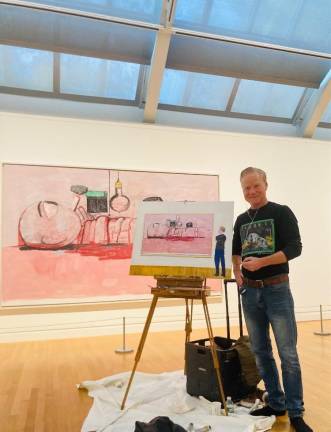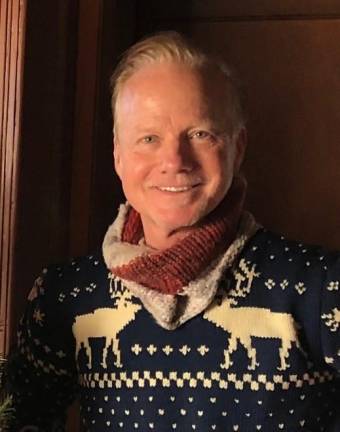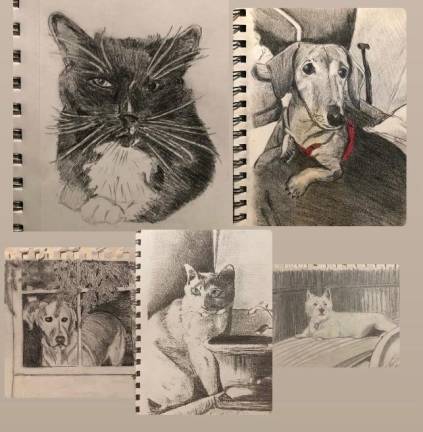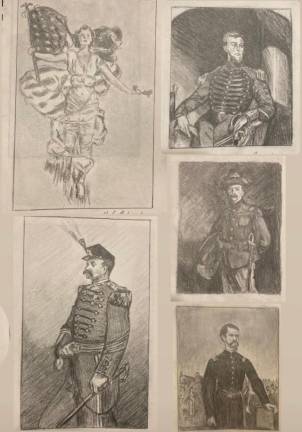This NYC Sketch Artist Gains Worldwide Recognition
Artist and actor Stephen Galiczynski on sketching at the Met, winning an international art contest at Rockefeller Center and drawing on the set of “Law & Order.”




For over 25 years, Upper West Sider Stephen Galiczynski has been walking or biking directly across Central Park to the Metropolitan Museum of Art to sketch its paintings. This past October, he was accepted into the Museum’s Copyist Program, which dates back to 1872, for sketching and painting, and just completed it in December. The program allows artists to bring their own supplies inside its famed doors and create reinterpretations of original artworks in its collection.
While he sketched there, he struck up conversations with artists from around the world. “One of the things that the people from the copyist program will say is that not all artists like to engage with people, so if you don’t like to, put headphones on and you can always just do your thing,” Galiczynski explained. “That’s not my character; I’m also an actor, so, to me, it’s performance art, And a lot of people took pictures and posted them on their Instagram accounts, so I had people tagging me from all over the world, which was very cool.”
Museums and art institutions from the Big Apple and across the globe have also taken notice of his work, and he’s been featured on the Instagram accounts of The Frick Collection, the Barnes Foundation, the Philadelphia Museum of Art, National Museum of Art of Romania, the Victoria and Albert Museum in London and the Neue Galerie New York.
Galiczynski, who grew up in Philadelphia and is the son of an artist, got a degree in Russian and started his career working as a translator. In the ‘80s, Galiczynski, whose SAG-AFTRA name is Steve Glenn, moved to New York and has acted on the soap opera “One Life to Live” and in movies like “Big Daddy,” and is also the sketch artist featured on TV shows like “Law & Order.”
Explain the Copyist Program at the Met for people who are unfamiliar with it.
It’s been in place since 1872 and it’s the only way artists can bring paint onto the premises. You have to apply for that. Now, there’s an online application, it’s your website or whatever art that you have, you submit. And then they choose the artists. Not all the pieces at the Met can be copied. You have to put applications in for the ones you want and for various reasons, you may not be able to do it. For instance, if it’s in the Modern Wing and it’s a carpeted area, they’ll never allow you to do it, because they don’t want paint on the carpet. Also, one that I wanted to do was too close to another painting, so people couldn’t get around me, so it would interrupt the flow of the guests. And I believe some of them are just not available. Also, there’s a limit on the size; you cannot paint a painting to the same size that it is and there’s a limitation. I think the biggest one is 30 by 28
How did you get into art?
My mom was an artist, my brother’s an artist. I’m the fifth of seven [children]. So there were always colored pencils and paintbrushes. We had a very large dining room table and my mom would just throw everything on the table. We got a lot of encouragement from our parents and my mom and it frees you up because you’re not afraid, like she said, “You never make a mistake, don’t even think like that.”
Tell us about your sketch of Philip Guston’s self-portrait Solitary Figure.
Copyists do the classics, like a Sargent, and I didn’t really want to do that because honestly, I’ve seen some really bad copies. I wanted to do something maybe somebody else didn’t do and I like Guston and this piece spoke to me. But the one thing I did do that it turned out nobody else had done in this 151-year history is I put the painting into a bigger context. So rather than just paint the painting or a piece of it, which has what’s been done up until now, I took the painting and added myself in, and put my self-portrait in looking at his self-portrait.
How did you become the first guest to enter the Met after COVID?
That was luck, I mean I figured I’d have to go over early because I knew there’d be a line. I didn’t even go over that early, I went over an hour or so early, maybe an hour and half. And when I got there, I thought, “Maybe I got the wrong day” because nobody was there. So I asked somebody, and they said, “Yeah, just stand on the top of the steps.” So then it very quickly got very crowded and I was interviewed by news media from around the world. PBS did a documentary on the Met called “Inside the Met,” and PBS interviewed me and I’m in that documentary.
You also won the Rockefeller Center Flag Project, and your design was made into a flag that hung on a pole at its skating rink.
The Met had a 150th anniversary design contest and it was international. I was one of the top 10 finalists. Initially, they were going to produce things and put it in their store for the top 10 finalists in each category, but then, COVID hit. Then, right after that, Rockefeller Center had an international contest, that they now run every year called The Flag Project. The flags that hang around Rockefeller Center, they take them down and they put the flags up from the winners. We were the first winners, since it was the first time they had the contest. I had a reception inside Rockefeller Center. I’m represented by an art dealer, Peg Alston, and like she said, I’ve never been to a reception inside Rockefeller Center. That was really cool. And then they rehung them the following year, so we were exhibited twice.
You’ve also done a lot of commissioned paintings. Tell us about some.
People will see a painting that I’ve done and say, “We would like something like that.” And then they send me ideas of what they want. I just did one this past year that was a seascape and that person, they hired me two years after I did a sketch of their cat, and they started to follow me. Now I do a lot of Madonnas, because the Madonnas won at the Metropolitan Museum and Rockefeller Center. They don’t have a religious significance, they can, but as pieces, it’s mother and child. So I’ve been commissioned to do a lot of them for new moms actually. And one of the things that makes them so original is I change all the races on the mother and children for different skin tones. It makes it more individual. I’ve done a lot of them over the past few years.
To learn more, visit www.stevegart.com